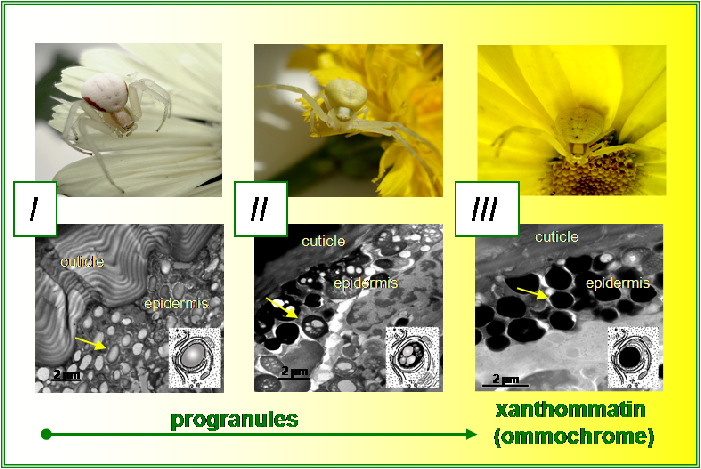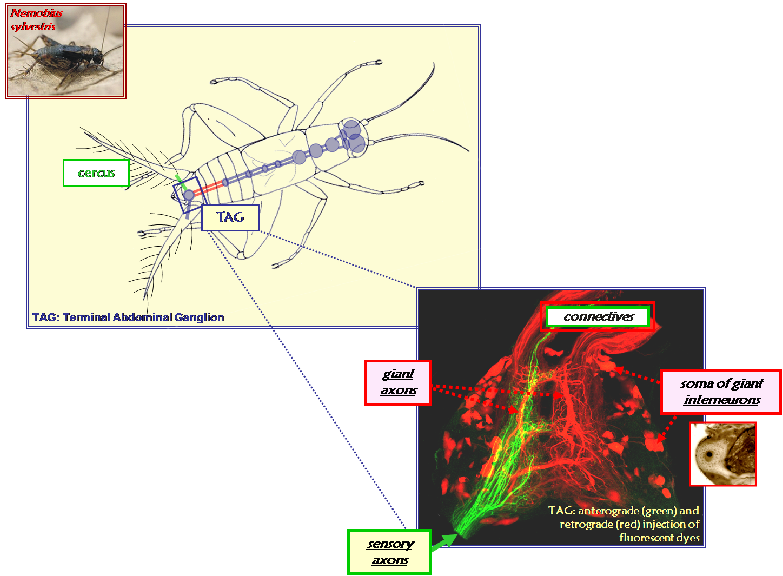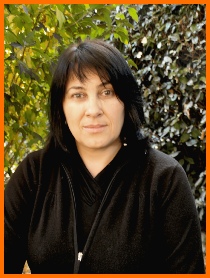My research interest is focused on the Insect Neuroanatomy and Functional Morphology. I am currently working mainly on two different projects: (1) "The cercal mechanosensory system of the wood cricket Nemobius sylvestris: neuroanatomy and physiology" and (2) "Morphological bases of colour change in crab-spiders".
In Nemobius sylvestris, by means of Optical, Confocal, Transmission Electron and Scanning Electron microscopy, combined with general and selective neuronal marking, we analysed the neuranatomical organization of the Terminal Abdominal Ganglion (TAG), the first relay for the treatment of mechanosensory inputs from the cerci, as well as the functional implications of this organization (Figure 1). Recently I started to analyse the processing of the sensorial information by the TAG by performing intracellular recordings from Giant Ascending Interneurons (GINs), associated to intracellular staining methods.
Misumena vatia is a colour changing mimetic crab-spider. The aims of our study are to characterize the localisation of major pigments in the spider body and to describe the formation and location of ommochrome granules, responsible for change from white to yellow colour. By means of light, fluorescent and electronic microscopy, we have analysed the processes of colour change and described de formation of the pigment granules (Figure 2).


Figure 1. The escape response of the wood cricket: the wind-sensitive cercal receptor/giant interneurons system.
Figure 2. In the colour-changing crab spider Misumena vatia ommochrome pigments are responsible for the yellow colour. The formation of ommochrome granules in epidermal cells proceeds in three distinctive steps (I, II, III). Translucent progranules (I) are produced by a dense network of endoplasmic reticulum. These progranules are present in white spiders only, and regularly distributed in the cytoplasm. The biochemical transformation of progranules of type I into
Publication List:
2009 Insausti, T.C., Casas, J., Turnover of pigment granules: Cyclic catabolism and anabolism of ommochromes within epidermal cells. Tissue Cell (2009), doi:10.1016/j.tice.2009.05.002
2008 Barrozo, R. B., Couton L., Lazzari C. R., Insausti T. C., Sebastian A. Minoli, Fresquet N., Rospars J. P. and Anton S. Antennal pathways in the central nervous system of a blood-sucking bug, Rhodnius prolixus. Arthropod Structure & Development, in press. DOI:10.1016/j.asd.2008.08.004.
2008 Insausti, T.C., Lazzari, C.R. and Casas, J. The terminal abdominal ganglion of the wood cricket Nemobius sylvestris. J. Morphol., in press. DOI: 10.1002/jmor.10672.
2008 Insausti, T. C. and Casas, J. The functional morphology of color changing in a spider: development of ommochrome pigment granules. J. Exp. Biol. 211: 780-789.
2008 Lazzari, C.R. and Insausti, T.C. Circadian rhythms in insects, In: M.L. Fajul-Moles & R. Aguilar-Roblero (eds.) Comparative aspects of circadian rhythms. Research Signpost (ISBN 978-81-7895-329-8), in press.
2007 Insausti, T.C., Lazzari, C.R. and Casas, J. A neuroanatomical guide of the cercal escape system of the wood cricket. Comp. Biochem. Physiol., Part A 148: S33
2009 Insausti, T.C., Casas, J., Turnover of pigment granules: Cyclic catabolism and anabolism of ommochromes within epidermal cells. Tissue Cell (2009), doi:10.1016/j.tice.2009.05.002
2008 Barrozo, R. B., Couton L., Lazzari C. R., Insausti T. C., Sebastian A. Minoli, Fresquet N., Rospars J. P. and Anton S. Antennal pathways in the central nervous system of a blood-
2008 Insausti, T.C., Lazzari, C.R. and Casas, J. The terminal abdominal ganglion of the wood cricket Nemobius sylvestris. J. Morphol., in press. DOI: 10.1002/jmor.10672.
2008 Insausti, T. C. and Casas, J. The functional morphology of color changing in a spider: development of ommochrome pigment granules. J. Exp. Biol. 211: 780-
2008 Lazzari, C.R. and Insausti, T.C. Circadian rhythms in insects, In: M.L. Fajul-
2007 Insausti, T.C., Lazzari, C.R. and Casas, J. A neuroanatomical guide of the cercal escape system of the wood cricket. Comp. Biochem. Physiol., Part A 148: S33
2002 Insausti, T.C. and Lazzari, C.R. The fine structure of the ocelli of Triatoma infestans (Hemiptera: Reduviidae) Tissue & Cell 34(6): 437-449.
2002 Reisenman, C.E., Insausti, T.C. and Lazzari, C.R. Light-induced and circadian changes in the compound eye of the haematophagous bug Triatoma infestans (Hemiptera: Reduviidae) J. Exp. Biol. 25(2): 201-210.
2000 Insausti, T.C.and Lazzari, C.R. The central projection of cephalic mechanosensory axons in the haematophagous bug Triatoma infestans. Mem. Inst. O. Cruz. 95: 381-388.
2000 Insausti, T.C. and Lazzari, C.R. The postembryonic development of the ocellar system of Triatoma infestans Klug (Heteroptera: Reduviidae). Mem. Inst. O. Cruz. 95 (6):877-881.
2000 Insausti, T.C. and Lazzari, C.R. An ocellar "pupil" that do not change with light intensity but with the insect age in Triatoma infestans. Mem. Inst. O. Cruz. 95(5): 743-746.
1999 Insausti, T.C.; Lazzari, C.R. and Campanucci, V.A. Neurobiology of Behaviour. A: Morphology of the nervous system and sense organs. En: Carcavallo et al. (eds.). Atlas of Chagas' disease vectors in America, vol. III, pp. 1017-1051, Editora Fiocruz, Rio de Janeiro.
1998 Lazzari, C.R.; Reisenman, C.E. and Insausti, T.C. The role of the ocelli in the phototactic response of Triatoma infestans (Heteroptera: Reduviidae). J. Insect Physiol. 44(12): 1159-1162.
1998 Reisenman, C.E.; Lazzari, C.R.; Insausti, T.C. and Giurfa, M. Attributes of the visual system of Triatoma



Dr. Teresita Concepciòn Insausti

2005-present. Postdoctoral Fellowship (eq. Ingénieur de recherche), IRBI (France).
1991-2003. Teaching and Research Associate Assistant, University of Buenos Aires (Argentina). PhD obtained in 1997.
1988-1990. Research Assistant, Institute of Biological Cybernetics, University of Tübingen (Germany).
Keywords:
Insect Neuroanatomy; Functional Morphology; Histology; Light and
Neuro-anatomy, physiology and functional morphology




